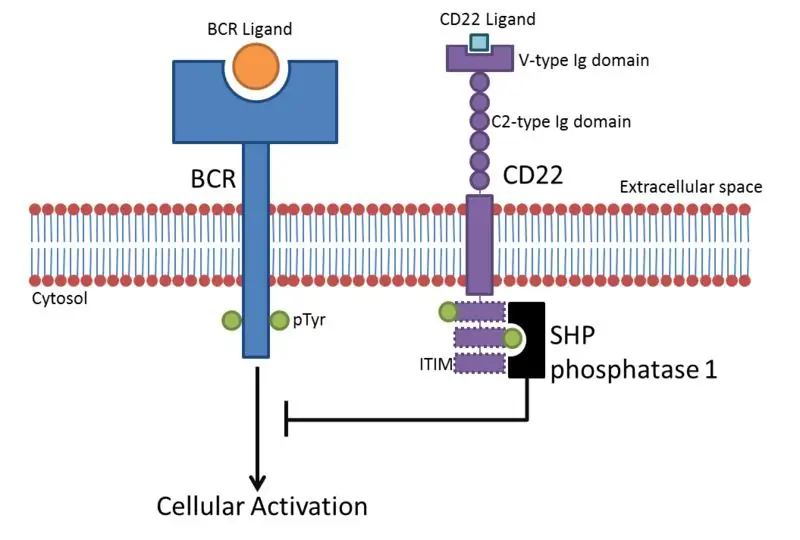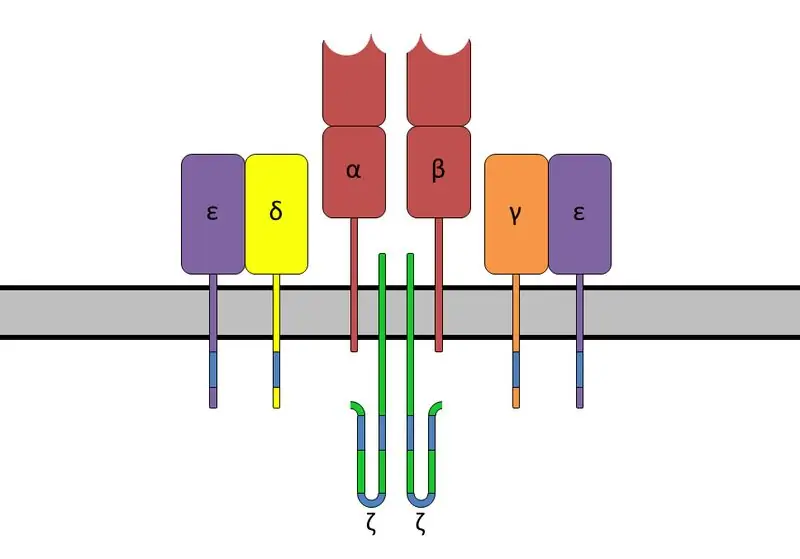- Автор Mildred Bawerman [email protected].
- Public 2023-12-16 08:37.
- Последно модифициран 2025-06-01 05:47.
Key Difference - B Cell Receptor vs T Cell Receptor
The defense system of the body is mainly developed with the presence of leukocytes which act against invading pathogens such as viruses and bacteria. Different types of leukocytes with different functions are present in the human body. B cells and T cells are the major leukocytes which involve in initiating specific immune responses. B cells function in the production of specific antibodies which involve in humoral adaptive immunity. T cells involve in cell mediated adaptive responses. Different responses are initiated by both cells. The receptors found in B cells and T cells are known as B cell receptors and T cell receptors respectively. The detection process of antigens differs according to the type of leukocyte as, either B cell or T cell. The B cell receptors bind to soluble antigens that are present freely whilst T cell receptors only recognize antigens when displayed on Major Histocompatibility Complex (MHC). This is the key difference between B cell receptor and T cell receptor.
CONTENTS
1. Overview and Key Difference
2. What is B Cell Receptor
3. What is T Cell Receptor
4. Similarities Between B Cell Receptor and T Cell Receptor
5. Side by Side Comparison - B Cell Receptor vs T Cell Receptor in Tabular Form
6. Summary
What is B Cell Receptor?
The B cell receptor (BCR) is a transmembrane receptor protein located on the outer surface of B cells. B cells are produced as well as mature in the bone marrow. The B cell development is initiated by the production of a functional pre-B cell receptor (pre-BCR). The pre-BCR consists of two immunoglobulin heavy chains and two surrogate light chains. These chains cooperate with IgA and IgB which are signaling molecules. The BCRs which is also known as integral membrane proteins reside in many identical copies at the surface of the B cells.
The B cell receptor complex is composed of an antigen binding subunit (MIg) which is made of two immunoglobulin heavy chains and two immunoglobulin light chains and a disulphide- linked heterodimer of Ig-alpha and Ig-beta proteins together, that make up a signaling subunit. The heavy chains of BCRs consist of gene segments like 51 VH, 25 DH, 6 JH and 9 CH. 51 VH segments that encode the N terminal of the antibody. This N terminal of the antibody includes the first two hyper-variable regions. 25 DH segment is a diversity gene segment which encodes the third part of the hyper-variable region. 6 JH is the joining gene segment which encodes the V region, and the 9 CH segment encodes the C region of the BCR.

Figure 01: B Cell Receptor
BCRs have a specific binding site, and this site binds to a region of the antigen called the antigenic determinant. The binding is aided by non-covalent forces, the complementarity of the receptor surface and the surface of the antigenic determinant. If the BCR is present on the surface of B lymphocytes, it transmits intracellular signals which help in the regulation of cell growth and differentiation while also binding to specific antigens to generate an immune response. Memory cells that move through the circulation to produce immune responses are also produced by the activation of BCRs. The antigens which are bound to this, occur with the engulfment by the B cells due to receptor-mediated endocytosis. Then the antigens are being digested into small fragments and are later displayed at the surface of the cells inside the class II histocompatibility molecule.
What is T Cell Receptor?
T cell receptor (TCR) is found on the surface of T lymphocytes. TCRs function is to recognize foreign particles known as antigens to initiate an immunological response. During normal conditions, the body develops and produces many T cells, and each of the cells possesses a unique TCR on its surface. The development of TCR occurs due to the recombination of genes which encode TCRs prior to the encounter of antigens. In the surface of a T cell, identical TCRs occur in larger quantities. The antigens which bind with the TCRs are small peptide particles which are epitopes that occur through the phagocytosis of the foreign pathogen. These epitopes are displayed by Major Histocompatibility Complex (MHC) molecules.
T cells are of two types. Cytotoxic T cells (Tc) and Helper T cells (Th). The TCRs present on Tc cells recognize foreign epitopes which are presented by MHC Class I molecules. They possess the ability to differentiate nonself (foreign) antigens from self-antigens. Therefore, it prevents the occurrence of immune responses against the body’s own cells. Th cells recognize antigens displayed on MHC Class II molecules. A surface glycoprotein CD8 in Tc cells and CD4 in Th involve during the binding process of the foreign epitope to both types of T cells. CD4 and CD8 co-receptors recognize antigens presented on MHC Class II and MHC Class I molecules respectively.

Figure 02: T Cell Receptor
The TCR is a transmembrane heterodimer which is composed of two chains. Thy typical structure of TCR is not sufficient in transducing a signal. This occurs due to the short cytoplasmic chains they possess. To overcome these situations, TCRs associate CD3 transmembrane proteins. The CDS complex consists of different subunits which include CDe, CDg, CDd and Z (CDz). This develops the TCR complex which is able to transduce a signal.
Due to the chance of binding a self-antigen by TCR, once an antigen gets bound to TCR, it does not initiate an immune response immediately. This is referred to as T cell tolerance. To initiate an immune response, the T cell (TCR) requires a second signal in the form of a co-stimulatory molecule derived from an antigen presenting cell.
What are the Similarities Between B Cell Receptor and T Cell Receptor?
- И двата рецептора са интегрални мембранни протеини.
- Представете на повърхността на клетката колкото се може повече идентични копия.
- И двата типа притежават уникални места за свързване.
- И двата типа рецептори са кодирани от гени, които се събират чрез рекомбинация на сегменти от ДНК.
- И двата рецептора се свързват с антигенната детерминантна част на антигена и свързването се осъществява чрез нековалентни сили.
Каква е разликата между В-клетъчния рецептор и Т-клетъчния рецептор?
Различна статия Средна преди таблица
B клетъчен рецептор срещу T клетъчен рецептор |
|
| В-клетъчният рецептор е трансмембранен рецепторен протеин, разположен на външната повърхност на В-клетките. | Т-клетъчният рецептор е разпознаваща антиген молекула, присъстваща на повърхността на Т-лимфоцитите. |
| Разпознаване на епитоп-антигени | |
| В-клетъчният рецептор разпознава разтворими антигени. | Т-клетъчният рецептор разпознава антигени, показани на молекули MHC клас I и MHC клас II. |
Резюме - B клетъчен рецептор срещу T клетъчен рецептор
В клетките и Т клетките са важни компоненти на имунната система. И двете клетки притежават рецептори на клетъчната повърхност, известни като BCR и TCR съответно. И двата рецептора са интегрални мембранни протеини и присъстват на клетъчната повърхност толкова много идентични копия. Както BCR, така и TCR притежават уникални места за свързване. Те се различават в процеса на разпознаване на антигени. BCR откриват и се свързват с разтворими антигени, които са налични свободно, докато TCR разпознава антигени само когато се показват в Основния комплекс за хистосъвместимост (MHC). Това е разликата между В-клетъчния рецептор и Т-клетъчния рецептор.
Изтеглете PDF версията на B Cell Receptor срещу T Cell Receptor
Можете да изтеглите PDF версия на тази статия и да я използвате за офлайн цели според бележката към цитата. Моля, изтеглете PDF версия тук Разлика между рецептор за B клетки и рецептор за T клетки






